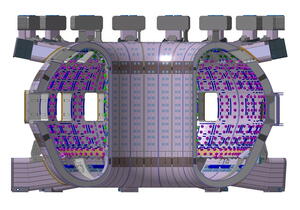Vacuum Vessel Procurement Arrangement ready for signature
The Vacuum Vessel Procurement Arrangement with Korea is ready for signature. "We have been through a real tour de force in order to establish all the required documents and technical specifications for this important Procurement Arrangement, which is one of the bigger procurement packages," says Gary Johnson, Deputy Director-General responsible for the Tokamak Department, "... and it is on the critical path."
The Procurement Arrangement includes the improvements coming from the Design Review 2007, which were approved as part of the technical baseline design by the last Council. One major result of this update was the development of in-vessel coils to provide control of the plasma's vertical stability as well as Edge Localized Modes (ELM) that otherwise could dump large amounts of energy into the plasma-facing components. Obviously the technical integration of these new features has an impact on the detailed design and the cost.
So the ITER Organization, together with its partners from the European Community and Korea, who will respectively supply 80 percent and 20 percent of the vessel, are assessing any possible means to mitigate risk, cost and schedule impact. In a one-day review with video participation from the involved Domestic Agencies in Barcelona and Seoul, the various options were discussed and a first evaluation presented. With value engineering in mind, an alternative design proposal for the vessel and the blanket has even been reviewed.
"As a result we proceed with the Procurement Arrangement for the vacuum vessel as planned, based on the present design, while in parallel we follow up on some of the ideas to be able to address manufacturability, risk and cost. This is the right time to go ahead in these directions, since feedback back is coming in from first contacts with potential vendors and we want to be prepared," says Norbert Holtkamp, Principal Deputy Director-General of the ITER Project.
One of the main features of an alternative proposal under discussion sees the inner wall of the vacuum vessel moved out by 150 mm, which would reduce the space between the two shells and thus allow more space for the installation of the ELM coils. Another is a simpler design of the support structure for the blanket housing that would require less welding time and thus could result in some cost reduction at the expense of schedule.
In the first week of November, a series of reviews will follow in order to address remaining open issues on the baseline design and develop a work plan to close them out by the beginning if next year. This is one of the first tasks the project's new Systems Integration Head, Gunther Janeschitz (see article in this issue), has to lead.


